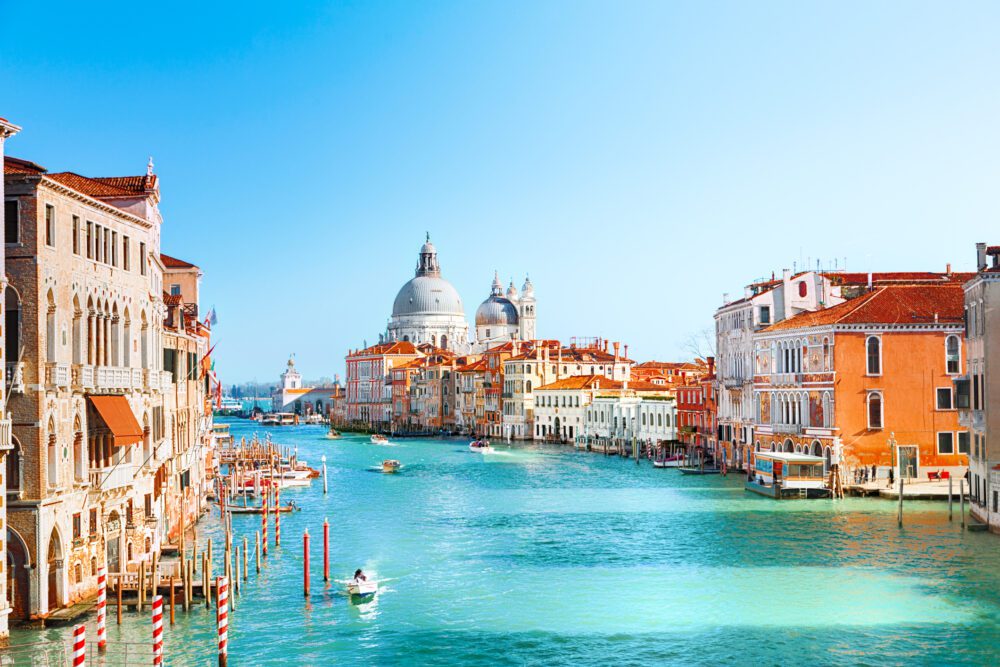
Introduction
Nestled in the picturesque Venetian Lagoon, Venice is a city unlike any other, renowned for its enchanting canals, historic architecture, and timeless beauty. Often referred to as the “Floating City,” Venice captivates visitors with its unique charm and romantic ambience. Steeped in centuries of history and culture, this UNESCO World Heritage Site is a living testament to the grandeur of the Venetian Republic, once a powerful maritime empire that dominated trade routes across the Mediterranean. From its iconic gondolas gliding along winding waterways to its magnificent palaces and ornate churches, Venice exudes an air of mystique and elegance that beckons travellers from around the globe.
Venice’s allure lies not only in its rich history but also in its vibrant atmosphere and cultural heritage. Home to world-class art, music, and cuisine, the city offers a myriad of experiences to delight the senses. Whether wandering through narrow alleyways lined with artisan workshops, savouring traditional Venetian cicchetti in a cosy bacaro, or marvelling at masterpieces by Titian and Tintoretto in renowned museums and galleries, Venice promises an unforgettable journey into the heart of Italian culture and romance. With every corner revealing a new treasure and every canal beckoning with the promise of adventure, Venice is a destination that captivates the imagination and leaves an indelible mark on the soul.
Table of Contents
Map of the Best Things to Do in Venice
Grand Canal

No visit to Venice is complete without a leisurely cruise along the Grand Canal, the city’s iconic waterway that serves as its main artery. Stretching for about 3.8 kilometres from the Santa Lucia train station to the San Marco Basin, the Grand Canal is lined with magnificent palaces, historic churches, and bustling waterfront markets, offering a captivating glimpse into Venice’s rich past and vibrant present. Originally dredged in the 9th century, the canal played a crucial role in the city’s development, serving as a vital thoroughfare for trade and transportation during the height of the Venetian Republic. Today, it remains a bustling hub of activity, with vaporetto water buses, sleek water taxis, and elegant gondolas navigating its shimmering waters, providing both locals and visitors with a convenient and scenic mode of transportation.
For the best experience, consider taking a vaporetto ride along the Grand Canal, allowing you to soak in the splendour of Venice’s architectural wonders from a unique perspective. Along the way, marvel at the grandeur of landmarks such as the Gothic-style Ca’ d’Oro, the opulent Palazzo Barbaro, and the magnificent Rialto Bridge, which spans the canal at its narrowest point. Don’t forget to bring your camera to capture the breathtaking vistas and colourful facades that line the water’s edge. Alternatively, opt for a romantic gondola ride for a more intimate and leisurely exploration of the Grand Canal, as skilled gondoliers serenade you with tales of Venice’s storied past while gliding beneath arched bridges and past historic palazzi.
Rialto Bridge
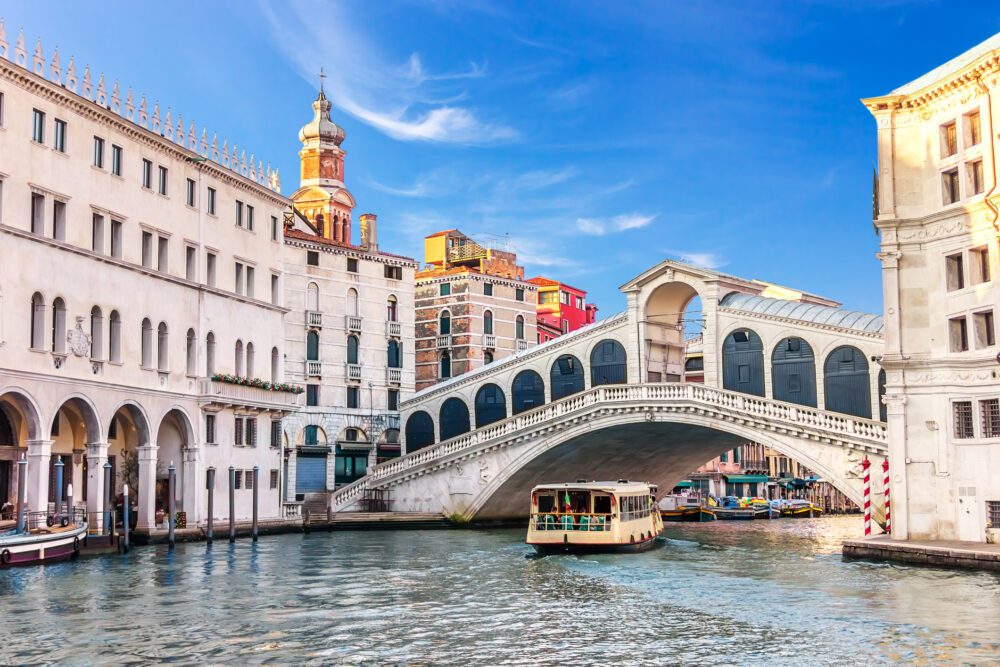
One of Venice’s most iconic landmarks, the Rialto Bridge, stands as a testament to the city’s architectural prowess and historical significance. Spanning the Grand Canal in the heart of Venice, the bridge has served as a vital link between the districts of San Marco and San Polo since its completion in 1591. Designed by architect Antonio da Ponte, the Rialto Bridge replaced several wooden bridges that had previously occupied the site, providing a more durable and impressive crossing for pedestrians and merchants alike. Its distinctive arched design, lined with rows of shops and stalls, has made it a beloved symbol of Venice and a popular gathering place for locals and tourists alike.
Visitors to the Rialto Bridge can enjoy stunning views of the Grand Canal and the bustling activity below, making it an ideal spot for taking photographs and immersing oneself in the vibrant atmosphere of Venice. The bridge’s central location also puts it within easy reach of several notable landmarks, including the bustling Rialto Market, where visitors can sample fresh produce, seafood, and other local delicacies. For the best experience, consider visiting the Rialto Bridge early in the morning or late in the evening to avoid the crowds and enjoy a more peaceful atmosphere. Additionally, exploring the surrounding area on foot allows you to discover hidden gems such as quaint alleyways, charming piazzas, and historic churches that capture the essence of Venice’s timeless allure.
Fondaco dei Tedeschi
Situated near the Rialto Bridge along the Grand Canal, the Fondaco dei Tedeschi is a historic building that has undergone a remarkable transformation into a vibrant shopping destination in Venice. Originally constructed in the 13th century as a trading post for German merchants, the Fondaco dei Tedeschi has played a significant role in the city’s commercial history. Over the centuries, it served various purposes, including as a warehouse, customs house, and post office, reflecting Venice’s position as a bustling hub of trade and commerce in the Mediterranean.
Today, the Fondaco dei Tedeschi has been meticulously restored and revitalized as a luxury shopping centre, offering an unparalleled shopping experience in the heart of Venice. Renowned architectural firm OMA led by Rem Koolhaas oversaw the renovation, preserving the building’s historic features while incorporating modern design elements. Visitors to the Fondaco dei Tedeschi can explore an array of high-end boutiques, fashion brands, and luxury goods, making it a premier destination for fashion enthusiasts and discerning shoppers. In addition to shopping, the building boasts a rooftop terrace with panoramic views of the city, providing a breathtaking vantage point to admire the iconic landmarks of Venice, including the Grand Canal and the Rialto Bridge.
Rialto Market
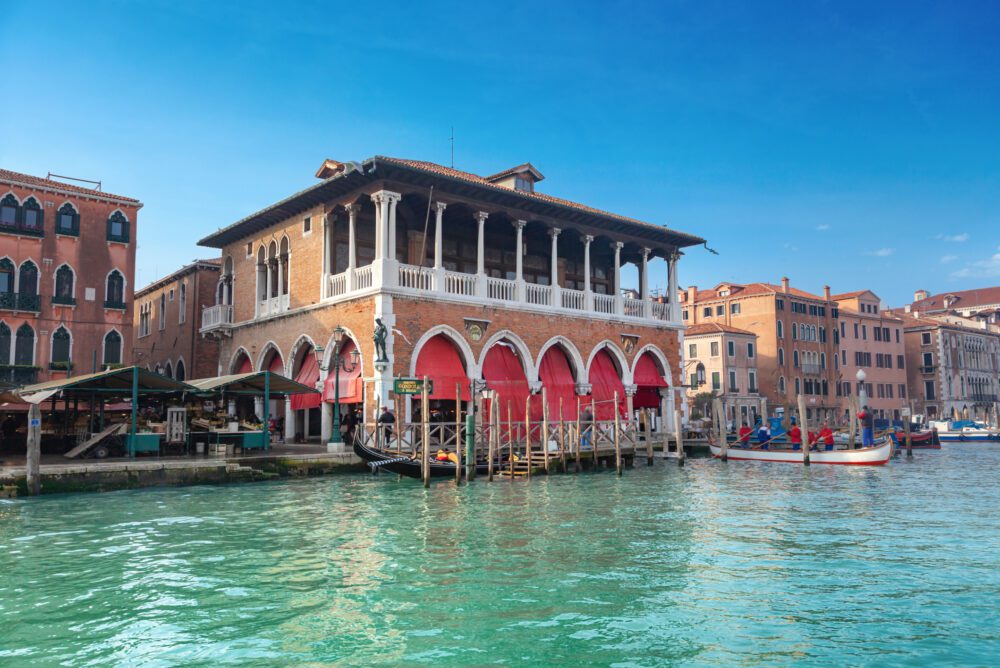
Located adjacent to the iconic Rialto Bridge, the Rialto Market is a vibrant and historic marketplace that has been a focal point of Venetian life for centuries. Dating back to the 11th century, the market has served as the city’s primary trading hub for fresh produce, seafood, and other goods, embodying Venice’s rich culinary traditions and maritime heritage. Over the years, the market has evolved into a bustling destination where locals and visitors alike can immerse themselves in the sights, sounds, and flavours of Venetian cuisine.
Today, the Rialto Market continues to enchant visitors with its lively atmosphere and diverse array of offerings. Divided into two sections, the Erberia (Greengrocer’s Market) and the Pescheria (Fish Market), the market is a feast for the senses, brimming with colourful fruits and vegetables, succulent seafood, fragrant spices, and artisanal products. Strolling through the stalls, visitors can interact with local vendors, sample seasonal delicacies, and experience the authentic flavours of Venetian gastronomy. Whether browsing for ingredients to prepare a home-cooked meal or simply soaking up the vibrant ambience, a visit to the Rialto Market is an essential part of any culinary exploration of Venice. For the ultimate experience, consider arriving early in the morning to witness the market at its liveliest, or visit later in the day to enjoy a stroll and perhaps indulge in a seafood lunch at one of the nearby trattorias.
Venetian Ghetto
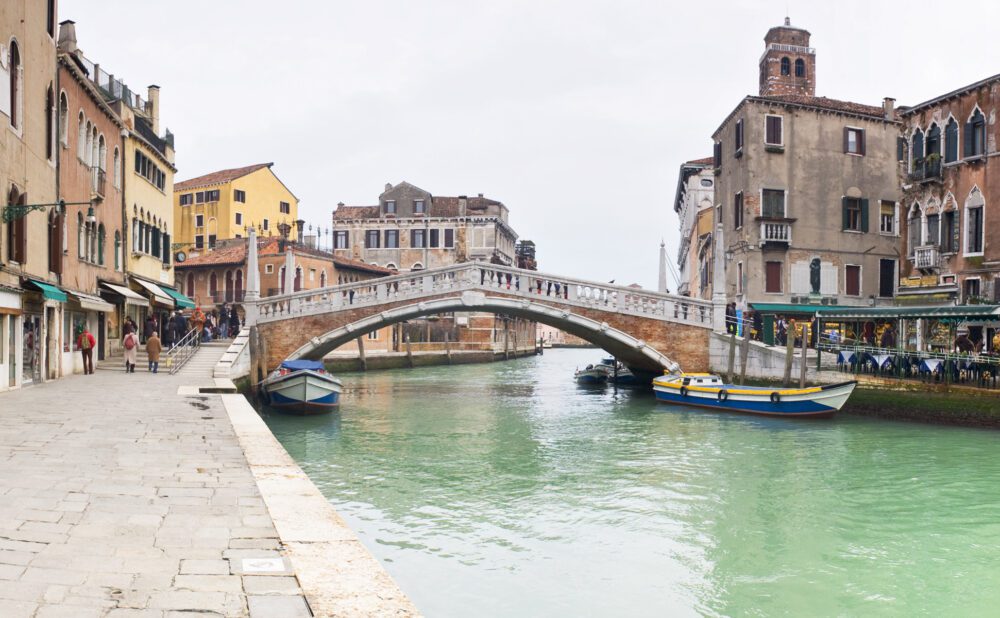
The Venetian Ghetto holds a significant place in both the history of Venice and the broader narrative of Jewish heritage in Europe. Established in 1516 by the Venetian Republic, it was the world’s first ghetto, a designated area where Jewish residents were required to live. Despite the restrictions imposed on them, the Jewish community thrived within the confines of the ghetto, fostering a rich cultural and religious life that left an indelible mark on the city. Over time, the ghetto became a centre of Jewish learning, commerce, and religious practice, with synagogues, schools, and businesses flourishing within its narrow streets and alleys.
Today, the Venetian Ghetto stands as a testament to the resilience of the Jewish people and the enduring spirit of tolerance and coexistence. Visitors to the ghetto can explore its historic synagogues, which showcase a blend of architectural styles reflecting the diverse origins of the Jewish community, from Italy to Spain to the Levant. Guided tours offer insights into the ghetto’s complex history and the lives of its inhabitants, while cultural institutions like the Jewish Museum of Venice provide further context and understanding. Additionally, the ghetto is home to a vibrant array of kosher eateries, bakeries, and shops, allowing visitors to sample traditional Jewish cuisine and purchase unique souvenirs.
Doge’s Palace

Doge’s Palace, or Palazzo Ducale, is a magnificent architectural gem located at the heart of Venice’s historic centre. This iconic landmark served as the seat of government and residence of the Doge, the ruler of the Venetian Republic, for centuries. Built in the Venetian Gothic style, the palace is adorned with intricate marble facades, elegant arches, and ornate balconies, showcasing the wealth and power of Venice during its golden age. Visitors can explore the opulent chambers where the Doge conducted affairs of state, admire masterpieces by renowned artists such as Titian and Tintoretto, and stroll across the iconic Bridge of Sighs, which connected the palace to the adjacent prison. Guided tours offer fascinating insights into the palace’s history, architecture, and the political intrigues that unfolded within its walls.
Practical tips for visiting Doge’s Palace include purchasing tickets in advance to avoid long queues, especially during peak tourist seasons. Audio guides are available in multiple languages for self-guided tours, providing detailed commentary on the palace’s highlights. Visitors should allocate sufficient time to explore the palace thoroughly, including its lavish ceremonial halls, imposing council chambers, and the atmospheric prison cells. Additionally, the Doge’s Palace often hosts special exhibitions and events, so it’s worth checking the schedule for any temporary attractions during your visit.
St Mark’s Square and Basilica
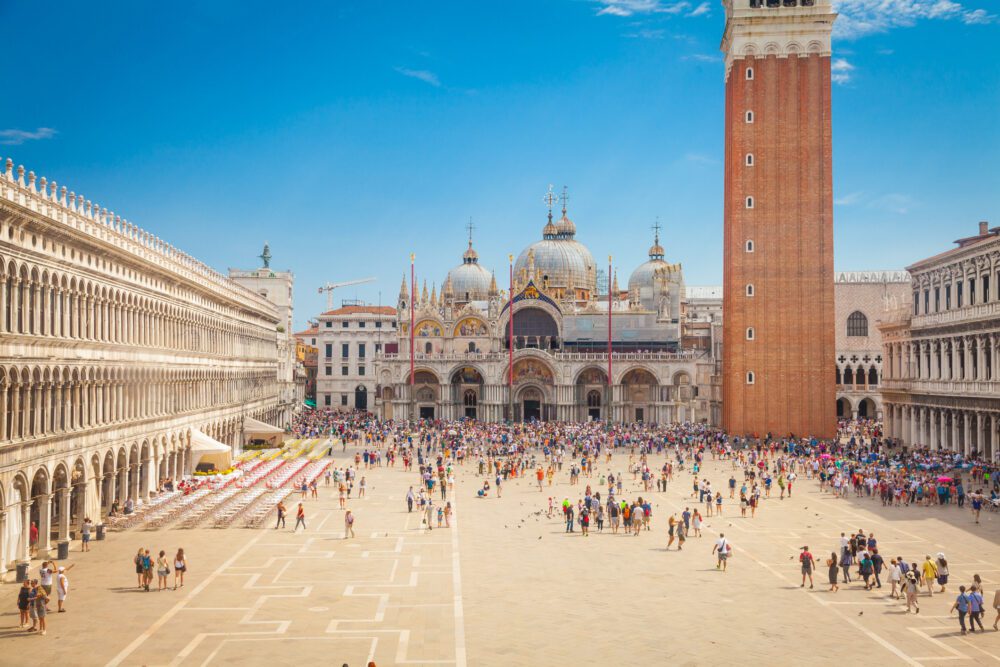
St. Mark’s Square (Piazza San Marco) and the adjacent St. Mark’s Basilica (Basilica di San Marco) stand as the symbolic heart of Venice, drawing visitors from around the world with their timeless beauty and historical significance. The square has been the centre of Venetian political, religious, and social life for over a millennium, serving as the main gathering place for locals and tourists alike. Enclosed by elegant arcades and lined with historic buildings, cafes, and shops, the square exudes a sense of grandeur and charm. St. Mark’s Basilica, one of the most renowned examples of Byzantine architecture in the world, dominates the square with its magnificent domes and intricate mosaics. Originally built in the 9th century to house the relics of Saint Mark, the basilica is adorned with stunning marble facades, intricate carvings, and shimmering gold mosaics depicting biblical scenes and saints.
Practical tips for visiting St. Mark’s Square and Basilica include arriving early in the morning or late in the evening to avoid crowds, as the area tends to get extremely busy during the day. Admission to the basilica is free, but visitors should be aware of the strict dress code and security measures in place, which may include bag checks and metal detectors. To avoid long queues, consider purchasing skip-the-line tickets or booking a guided tour that includes priority access to the basilica. Inside the basilica, visitors can marvel at the breathtaking mosaics covering the walls and domes, explore the treasury containing precious relics and artefacts, and climb to the rooftop terrace for panoramic views of the square and the surrounding cityscape.
Bridge of Sighs
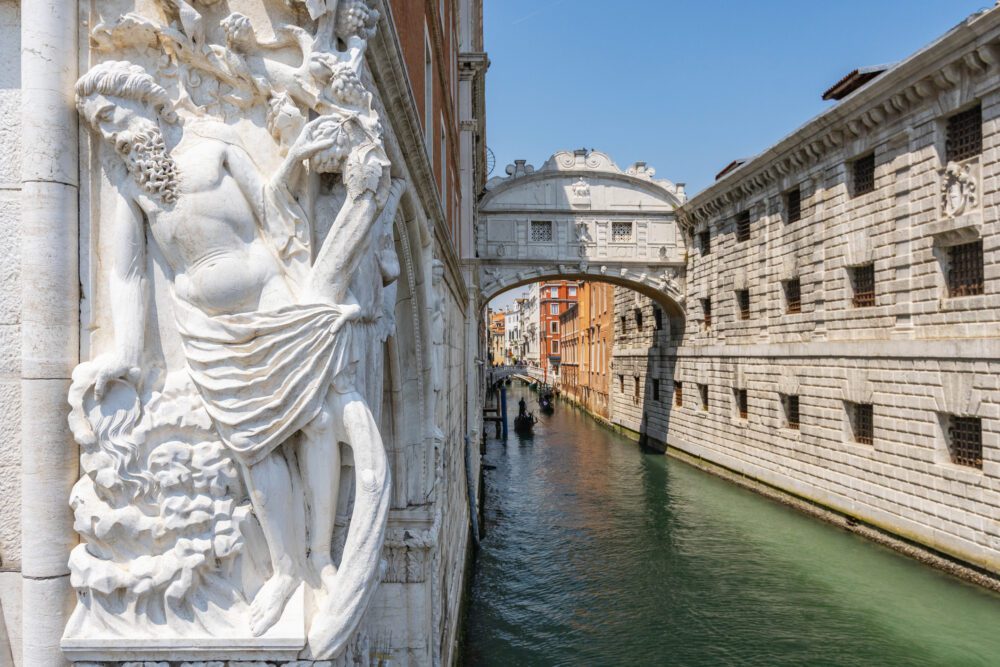
The Bridge of Sighs (Ponte dei Sospiri) is one of Venice’s most iconic landmarks, renowned for its romantic allure and fascinating history. This ornate bridge spans the Rio di Palazzo and connects the Doge’s Palace to the New Prison. Built in the early 17th century, the Bridge of Sighs earned its name from the sighs of prisoners who, according to legend, would catch their final glimpse of the outside world as they crossed from the interrogation rooms in the palace to their prison cells. The bridge’s delicate stone tracery and small windows create an atmosphere of melancholy and mystery, inspiring poets, artists, and lovers for centuries.
Practical tips for experiencing the Bridge of Sighs include viewing it from the outside to admire its architectural beauty and capturing stunning photographs of its reflection in the canal below. While visitors cannot cross the bridge itself, they can appreciate its significance from nearby vantage points along the waterfront. For a more immersive experience, consider taking a guided tour of the Doge’s Palace, which often includes access to the interrogation rooms and prison cells linked by the Bridge of Sighs. By learning about the bridge’s history and the stories of those who passed through it, visitors gain a deeper appreciation for this emblematic symbol of Venice’s past.
Palazzo Contarini del Bovolo
Tucked away in a quiet corner of Venice, the Palazzo Contarini del Bovolo is a hidden gem waiting to be discovered by visitors seeking off-the-beaten-path attractions. Dating back to the 15th century, this Renaissance palace is renowned for its distinctive spiral staircase, known as the “bovolo,” which means “snail” in Venetian dialect. The staircase is a masterpiece of architectural ingenuity, featuring a series of arches and columns that wind upwards in a graceful spiral, culminating in a rooftop terrace offering panoramic views of Venice’s rooftops and bell towers. Originally commissioned by the Contarini family, the palazzo underwent several renovations over the centuries before being restored to its former glory in recent years.
Practical tips for visiting the Palazzo Contarini del Bovolo include purchasing tickets in advance to avoid long queues, as access to the staircase is limited to a small number of visitors at a time. While exploring the palazzo, take time to admire the intricate details of the staircase’s design and marvel at the views from the rooftop terrace, which provide a unique perspective of Venice’s architectural landscape. Additionally, consider joining a guided tour to learn more about the history and significance of this lesser-known architectural gem.
Teatro La Fenice
Teatro La Fenice, meaning “The Phoenix,” is one of Italy’s most iconic opera houses, renowned for its rich history, stunning architecture, and world-class performances. Located in the heart of Venice, this historic theatre has risen from the ashes several times, earning its name as a symbol of resilience and rebirth. Originally built in 1792, La Fenice was destroyed by fire twice, in 1836 and 1996, only to be meticulously rebuilt each time to preserve its original splendour. The theatre’s ornate interior features intricate frescoes, gilded decorations, and plush velvet seating, creating an atmosphere of opulence and grandeur that transports visitors back to the golden age of Italian opera.
Practical tips for visiting Teatro La Fenice include booking tickets in advance to secure seats for performances, which often sell out quickly due to the theatre’s popularity. Additionally, guided tours of the theatre are available, providing insights into its history, architecture, and backstage areas. Visitors can also opt to attend a rehearsal or concert at La Fenice to experience the magic of live opera or classical music in this historic venue.
Peggy Guggenheim Collection
The Peggy Guggenheim Collection, situated along the Grand Canal in Venice’s Dorsoduro district, is a must-visit destination for art enthusiasts and culture lovers alike. Housed in the stunning Palazzo Venier dei Leoni, this museum showcases the impressive collection of modern and contemporary art amassed by the renowned American art collector Peggy Guggenheim. The collection features works by some of the most significant artists of the 20th century, including Pablo Picasso, Jackson Pollock, Salvador Dalí, and Wassily Kandinsky, among others. Peggy Guggenheim, an influential figure in the art world, played a crucial role in promoting avant-garde art movements such as Surrealism and Abstract Expressionism, and her collection reflects her eclectic taste and unwavering support for emerging artists.
Practical tips for visiting the Peggy Guggenheim Collection include purchasing tickets online in advance to avoid long lines, especially during peak tourist seasons. Guided tours are available for those seeking deeper insights into the artworks and Peggy Guggenheim’s fascinating life story. Visitors can explore the museum’s diverse galleries, sculpture garden, and temporary exhibitions at their own pace, taking in iconic masterpieces and lesser-known gems alike. Additionally, the museum’s picturesque location along the Grand Canal offers stunning views of Venice’s historic architecture, making it a perfect stop for both art aficionados and travellers looking to immerse themselves in the city’s vibrant cultural scene.
Basilica di Santa Maria della Salute
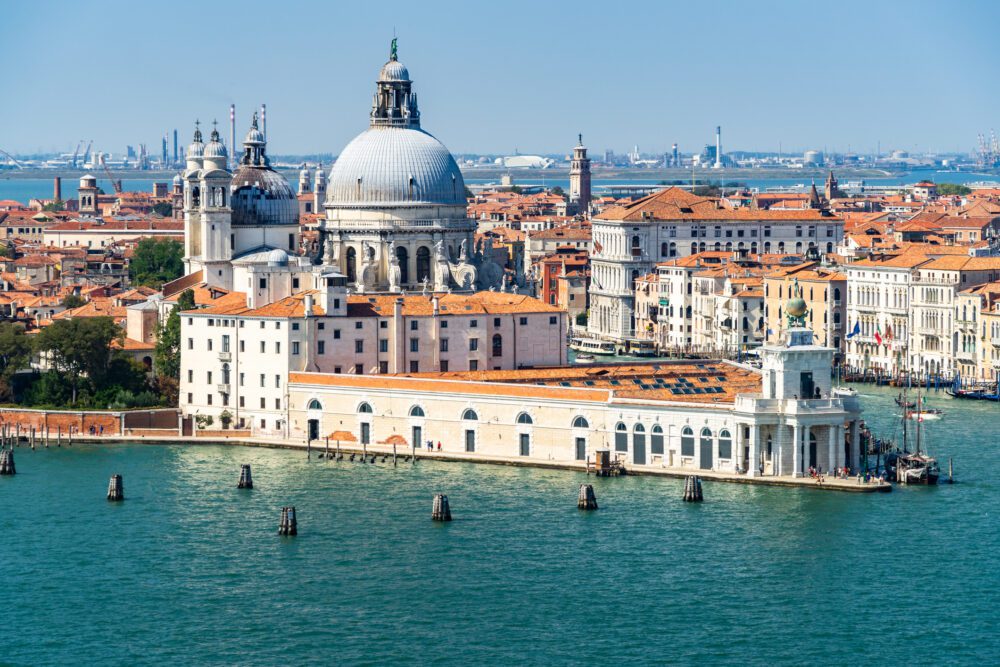
The Basilica di Santa Maria della Salute, commonly known as La Salute, is one of Venice’s most iconic landmarks, situated at the entrance of the Grand Canal in the Dorsoduro district. Built as a votive offering in gratitude for the city’s deliverance from the plague of 1630, this majestic baroque church stands as a testament to Venetians’ resilience and faith. Designed by renowned architect Baldassare Longhena, La Salute boasts a stunning octagonal dome and an elaborate facade adorned with sculptures and reliefs depicting scenes from the Virgin Mary’s life. Inside, visitors can admire magnificent artworks by prominent Venetian masters such as Titian, Tintoretto, and Paolo Veronese, including the impressive high altar dedicated to the Madonna.
When visiting La Salute, it’s essential to respect the church’s religious significance and dress modestly. Visitors should be mindful of the basilica’s opening hours and any ongoing religious services that may limit access to certain areas. Climbing the church’s dome offers breathtaking panoramic views of Venice and the surrounding lagoon, making it a worthwhile experience for those seeking memorable vistas of the cityscape. Additionally, exploring the tranquil promenade surrounding La Salute provides an opportunity to appreciate its architectural splendour from various angles while enjoying a stroll along the waterfront.
San Giorgio Maggiore
San Giorgio Maggiore is a stunning architectural gem located on the island of the same name, directly opposite St. Mark’s Square across the Grand Canal. Designed by Andrea Palladio in the 16th century, this masterpiece of Renaissance architecture is renowned for its harmonious proportions and classical beauty. The basilica’s facade features towering Corinthian columns, elegant arches, and a magnificent dome, creating a striking silhouette against the Venetian skyline. Inside, visitors can admire exquisite artworks by renowned Venetian artists such as Tintoretto and Jacopo Bassano, including the impressive altarpiece depicting the Last Supper by Tintoretto.
To reach San Giorgio Maggiore, visitors can take a short vaporetto ride from St. Mark’s Square or the San Zaccaria stop. Upon arrival, exploring the basilica’s interior reveals a treasure trove of artistic and architectural delights, from intricate marble floors to intricately carved wooden choir stalls. Climbing to the top of the bell tower offers panoramic views of Venice, providing a unique perspective of the city’s iconic landmarks, including St. Mark’s Campanile and the Doge’s Palace. Additionally, the island of San Giorgio Maggiore is home to the Giorgio Cini Foundation, a cultural centre that hosts exhibitions, concerts, and events throughout the year, making it an enriching destination for art and culture enthusiasts.
Scuola Grande di San Rocco
The Scuola Grande di San Rocco is a magnificent Renaissance building located in the San Polo district of Venice. Constructed in the 16th century, this grand edifice served as the headquarters for the Scuola di San Rocco, a confraternity devoted to the veneration of Saint Roch, who was believed to protect the city from the plague. The Scuola is most famous for its extensive collection of paintings by the renowned Venetian artist, Tintoretto. Visitors to the Scuola Grande di San Rocco can marvel at Tintoretto’s masterpieces, including his monumental series of paintings depicting scenes from the life of Christ and the Virgin Mary. The highlight of the collection is the breathtaking Crucifixion, located in the Sala dell’Albergo, which showcases Tintoretto’s unparalleled skill in capturing dramatic movement and emotion.
Practical tips for visiting the Scuola Grande di San Rocco include purchasing tickets in advance to avoid long queues, as this attraction can get quite busy, especially during peak tourist seasons. Additionally, visitors should take the time to explore the intricately decorated interior of the Scuola, which features stunning architectural details and elaborate stucco decorations. Guided tours are available for those who wish to gain deeper insights into the history and significance of this historic institution.
Murano, Burano, and Torcello Islands
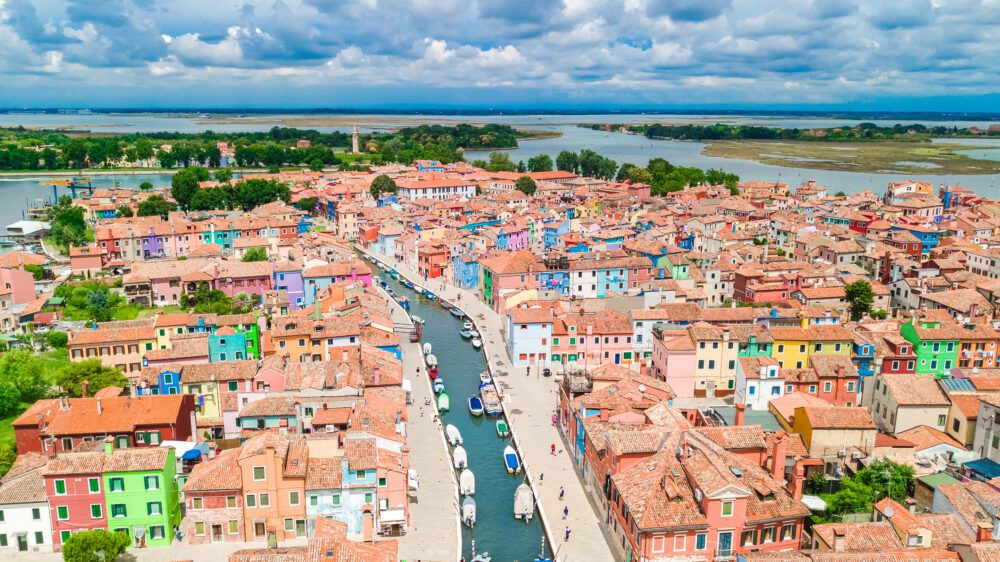
The islands of Murano, Burano, and Torcello are three captivating destinations that lie within the Venetian Lagoon, just a short boat ride away from Venice. Each island offers its own unique charm and attractions, making them popular day trip destinations for visitors to Venice. Murano is renowned for its centuries-old tradition of glassmaking, with numerous glass factories and workshops where visitors can witness skilled artisans at work creating exquisite glassware using age-old techniques. The island’s Glass Museum provides further insight into the history and artistry of Murano glass, showcasing a stunning collection of glass artefacts dating back to ancient times.
Burano, known for its colourful fishermen’s houses and picturesque canals, is a photographer’s paradise. Visitors can stroll along the charming streets lined with brightly painted houses and browse the local shops selling lace, which Burano is also famous for. Additionally, the island is home to the Lace Museum, where visitors can learn about the intricate art of lace-making that has been practised here for centuries. Meanwhile, Torcello is the most tranquil and least developed of the three islands, offering a peaceful escape from the crowds of Venice. Visitors can explore the island’s historic landmarks, including the Cathedral of Santa Maria Assunta with its stunning mosaics, and enjoy the serene atmosphere of its lush gardens and marshlands. Practical tips for visiting these islands include taking a vaporetto (water bus) from Venice, purchasing a day pass for unlimited travel within the lagoon, and planning to spend at least a few hours on each island to fully appreciate their beauty and attractions.
Conclusion
Exploring Venice and its surrounding islands offers an unforgettable journey through history, art, and culture. From the grandeur of St. Mark’s Square to the charming canals of Murano, Burano, and Torcello, every corner of this enchanting city is filled with beauty and wonder. Whether you’re admiring the masterpieces of Venetian architecture, indulging in delicious Venetian cuisine, or simply taking a leisurely gondola ride along the iconic Grand Canal, Venice never fails to captivate and inspire.
As you bid farewell to Venice, you’ll carry with you memories of its timeless beauty and the unique experiences you’ve enjoyed. Whether it’s your first visit or a return trip to this magical city, Venice’s allure remains as strong as ever, beckoning travellers from around the world to discover its secrets and treasures. From its rich history and cultural heritage to its breathtaking landscapes and vibrant atmosphere, Venice truly is a destination like no other.
